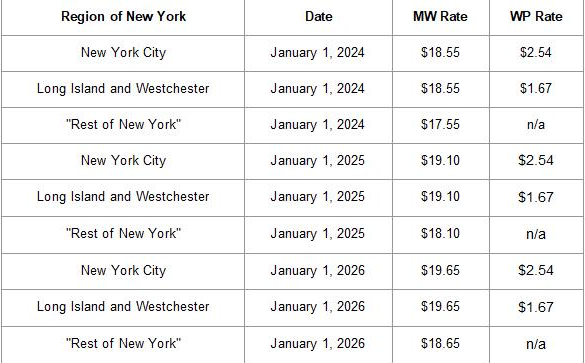Minimum Wage and Wage Parity
The final health and employment bills in the New York State Budget were signed last night. We reported several days ago on the wage parity and minimum wage changes from this year’s Budget as they apply to home care workers. As reported, the following are the newly scheduled minimum and wage parity rates taking effect:
- January 1, 2024: The home care worker minimum wage for New York City, Westchester, and Long Island will increase to $18.55/hour with the wage parity benefit portion of $3.22 or $4.09 being reduced by $1.55. The minimum wage for the rest of New York State will increase to $17.55.
- January 1, 2025: The home care worker minimum wage for New York City, Westchester, and Long Island will increase to $19.10/hour. The minimum wage for the rest of New York State will increase to $18.10.
- January 1, 2026: The home care worker minimum wage for New York City, Westchester, and Long Island will increase to $19.65/hour. The minimum wage for the rest of New York State will increase to $18.65.
We have heard, but are still confirming, that SEIU1199 has lobbied for and, reportedly, secured additional QIVAPP funding to help offset the wage parity benefit subsidy reductions that are slated to take effect as a result of this Budget. As our readers know, the millions of dollars in QIVAPP will only go to home care providers whose workers are represented by SEIU1199 and a handful of other agencies whose workers are not represented by SEIU1199.
The Budget Contains a Significantly Reduced MLTC Oversight Standard than Proposed by Governor
As we had previously reported, the Budget was proposed to have a MLTC RFO-type system and approval process for managed care organizations. Based on the final Budget language that was passed, effective January 1, 2024, every MLTC that is currently authorized to operate will need to have a Medicare Dual Eligible Special Needs Plan in operation with a CMS Quality Star Rating of 3 stars or higher (with plans that do not have the rating being exempted). The MLTC will be required to “sufficiently demonstrate” “success” in the following performance metrics:
- To “ensure network adequacy,” a “commitment to contracting with ‘adequate’ number of [LHCSAs and FIs] needed to provide necessary personal care services to the greatest practicable number of enrollees …”
- Readiness to timely implement and adhere to the maximum wait time criteria for key categories of service
- Commitment to quality improvement
- Accessibility and geographic distribution of network providers, taking into account the needs of persons with disabilities and the differences between rural, suburban, and urban settings
- Demonstrated cultural and language competencies specific to the population of participants
- Ability to serve enrollees across the continuum of care, as demonstrated by the type and number of products the MLTC operates or has applied to operate
- Value-based care readiness and experience
Many of the terms quoted above are not defined, so it is not clear what and how much the Department of Health will operationalize these Budget provisions to oversee and manage plans. The Commissioner could define what an “adequate” number of LHCSA and FI contracts could be, but it is more likely that the Department will just leave these decisions to be made by plans on a case-by-case basis.
Budget Cracks Down on Staffing Agencies that Serve Healthcare Providers
The Budget creates registration and significant transparency and reporting requirements for “temporary health care services agencies” and “health care technology platforms,” which the Budget defines to mean “a person, firm, corporation, partnership, association or other entity in the business of providing or procuring temporary employment of health care personnel for health care entities.” Notably, mobile app companies and nurses’ registries are included in this definition. Excluded from the definition, and the law’s coverage, are LHCSAs and solo 1099 healthcare staff that are directly engaged by the covered healthcare provider. The law applies to “health care personnel,” which is defined to include CNAs, nurses, and other licensed or unlicensed direct care staff “provided by the temporary care services agency to provide temporary services.” For purposes of the law, a “health care entity” means an agency, corporation, facility, or individual providing medical or health care services.
Registration Requirements
Effective upon the issuance of regulations by the Department of Health (“DOH”), the Commissioner will require any operator of a temporary health care services agency (“staffing agency” or “agency”) to register that staffing agency with the DOH. The Commissioner will publish guidelines establishing the forms and procedures for the registration, but the forms will require the following information:
- the name and address of any controlling person of that staffing agency
- the name and address of healthcare entities where the controlling person or their family members have an ownership relationship or direct the management or policies of such healthcare entities. In other words, the DOH intends to go to the “nucleus” of the ownership structure
- a demonstration that the applicant is of good moral character and able to comply with all applicable state laws and regulations relating to the activities in which it intends to engage. There is no indication of what factors the DOH we’ll consider in this analysis.
- Registration and related annual renewal fees of $1000
As a condition of the registration, a staffing agency will be required to:
- Document that each healthcare personnel provided to or contracted with healthcare entities meets the minimum licensing, training, and continuing education standards for the position in which the healthcare personnel will work
- Shall comply with all “pertinent” requirements and qualifications for personnel employed in healthcare entities
- Shall not restrict in any manner the employment opportunities of its healthcare personnel (which means that the staffing agency cannot have restrictive covenants, such as non-competes, in place with the staff)
- Shall not require the payment of liquidated damages, employment fees, or other compensation should the temporary staff be hired permanently by the facility where they were placed to work
- Shall retain all records for six years and make them available to the DOH upon request
- Shall comply with any requests made by the DOH to examine the books and records of the agency, subpoena witnesses, and documents, and make such other investigation as is necessary in the event that the DOH has reason to believe that the books are records do not accurately reflect the financial condition or financial transactions of the agency.
The registration issued by the DOH to any Staffing Agency will be effective for one year.
Transfer of Ownership
When ownership interests of 10% or more, or management of a staffing agency, is sold or transferred, the registration of the staffing agency may be transferred to the new owner or operator for 30 days, or until the new owner or operator applies and is granted or denied a new registration by the DOH, whichever is sooner.
Public Notices and Reporting
The Commissioner of Health will make available a list of all staffing agencies that are registered with the DOH on its website.
The DOH will also publish a quarterly report, containing aggregated and “de-identified” data collected pursuant to this law.
The staffing agency must submit to the DOH copies of all contracts with healthcare facilities to which it assigns or refers healthcare personnel and copies of “all invoices to healthcare entities’ personnel. “The executed contracts must be sent to the DOH within 5 business days of their effective date and are not subject to disclosure under the Freedom of Information Law (“FOIL”).
Minimum Standards for Operations
The new law sets the minimum standards for the operation of the staffing agencies, as follows:
- The staffing agency must appoint an administrator qualified by training, experience, or education to operate the staffing agency. Again, there is no indication of the level of experience, training, or education sufficient to meet this standard.
- Every staffing agency location must have its own administrator.
- The staffing agency must maintain a written agreement or contract with each healthcare facility with which it contracts, and the law establishes the minimum requirements for those contracts.
Compensation for Services
Staffing agencies will be required to report quarterly to the DOH a full list of charges and compensation, including a schedule of all hourly billing rates per category of healthcare personnel, a full description of any administrative charges, and a schedule of rates of all compensation per category of healthcare personnel, including but not limited to the following information:
- Hourly regular pay rate, shift differential, weekend differential, hazard pay, charge nurse ad-on, overtime, holiday pay, travel or mileage pay, and any health or other fringe benefits provided,
- The percentage of healthcare entity dollars that the agency spent on temporary staffing wages and benefits compared to the agency’s profits and other administrative costs,
- A list of the States and zip codes of the healthcare personnel’s primary residences
- The names of all healthcare entities that the staffing agencies contract with in New York State
- The number of healthcare personnel of the staffing agency working at each entity, and
- Any other information that may be required by the Commissioner of Health
Enforcement and Penalties
The New York Attorney General may, upon the request of the DOH, bring an action for an injunction against any individual or entity violating this law. “In addition to other remedies available by law,” violations of this law will be subject to penalties and fines, with each violation committed by any healthcare personnel of a staffing agency being considered a separate violation.










